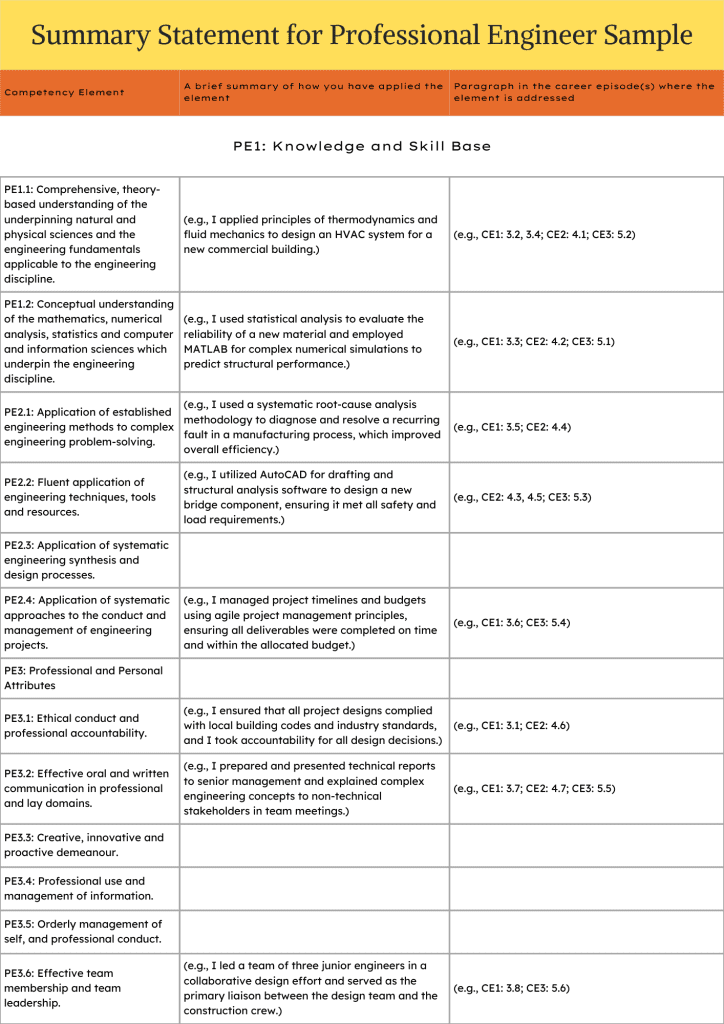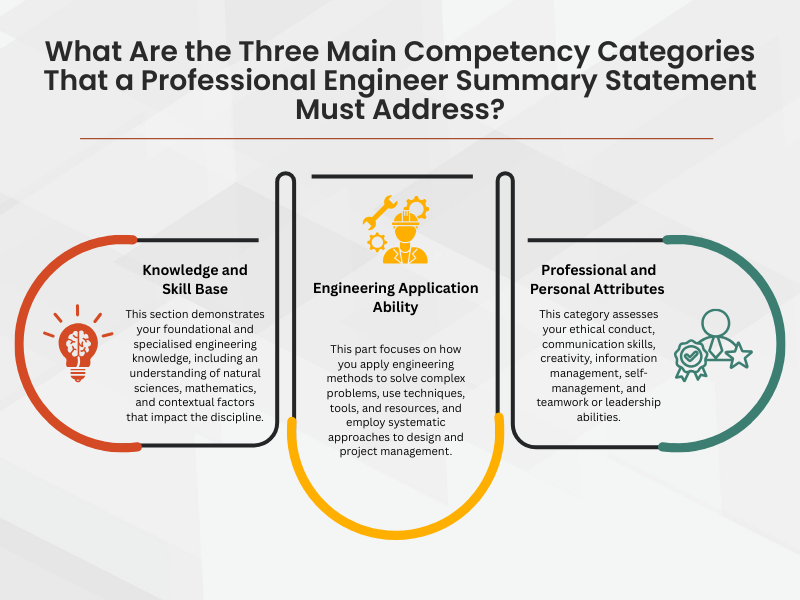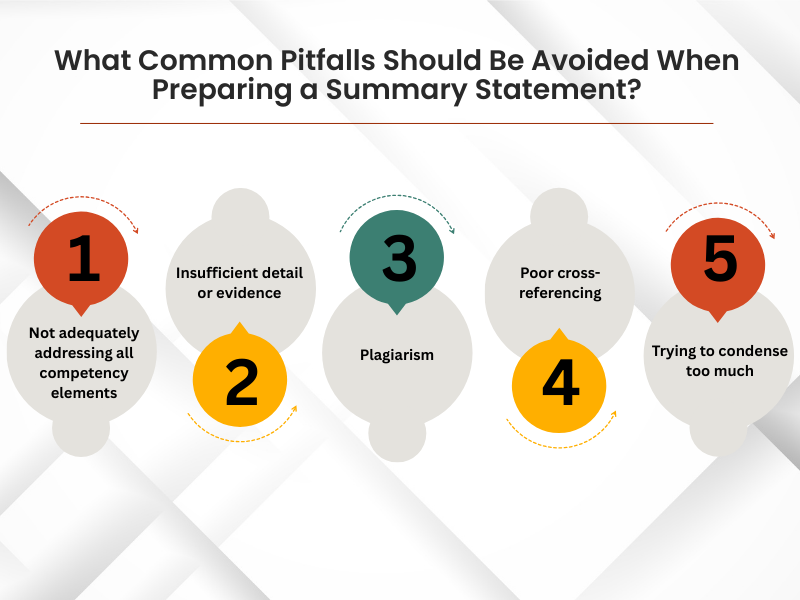After pouring countless hours into perfecting your Career Episodes, it all comes down to this: a single-page Summary Statement. This isn’t just a formality; it’s the very first document an assessor from Engineers Australia will review, and it’s the primary point where promising applications often falter. How do you ensure your statement acts as a powerful first impression that proves your competence, rather than a final roadblock to your career in Australia? This guide provides the blueprint.
So, before we dive deep into how to write a summary statement for professional engineer category, let’s see what else you will learn now!
Table of Contents
ToggleQuick Summary
- Your Critical First Impression: This one-page statement is the first document an Engineers Australia assessor reads and is crucial for proving your competence in your Competency Demonstration Report (CDR).
- Structured Around Three Core Competencies: The entire statement is built to demonstrate your capabilities in three specific areas: Knowledge and Skill Base (PE1), Engineering Application Ability (PE2), and Professional and Personal Attributes (PE3).
- The Blueprint of Your Experience: Its main job is to act as a roadmap, mapping the skills and experiences you detailed in your Career Episodes directly to each required competency standard.
- Paragraph Referencing is Key: You must use precise paragraph numbers to cross-reference every claim you make in the summary statement (SS), guiding the assessor to the exact evidence within your Career Episodes.
- Avoid Common Roadblocks: Success depends on avoiding critical errors such as incomplete sections, incorrect paragraph numbers that frustrate assessors, and plagiarism.
What Is a Professional Engineer Summary Statement in CDR Report?
A Professional Engineer Summary Statement is a crucial document required for skill assessment, particularly by Engineers Australia (EA), for engineers like you seeking to migrate or practice in Australia.
In short, this document summarises how you have applied your engineering knowledge, skills, and attributes, as demonstrated in your Career Episodes. The Summary Statement cross-references specific paragraphs in the Career Episodes where each competency element is addressed, providing evaluators with an organised overview of your capabilities. Consequently, it is essential to maintain the proper structure as outlined by the EA (Engineers Australia) to ensure a positive skill migration assessment.
In short, the SS in a CDR is a tabular overview that links specific engineering competencies to paragraphs within the Career Episodes. It is like a content table at a glance, which allows EA assessors to quickly verify the Engineering applicant’s skills and how they were applied in practice.
How to Write a CDR Summary Statement: A Step-by-Step Guide

Writing a Summary Statement that gets your positive outcome is a methodical process. Our CDR Writing experts have come up with a five-step structure that will help you carefully connect your experience to the required standards of EA and create a document that is clear, convincing, and easy for the assessor to approve:
Step 1: Understand the Competency Standards
Before you write a single word, you must intimately understand the criteria you are being assessed against. For the Professional Engineer category, the Stage 2 Competency Standards apply.
- Action: Download the official summary statement template for Professional Engineer directly from the Engineers Australia website. This document lists every competency element you must address (PE1.1, PE2.3, PE3.4, etc.).
- Why it’s critical: You cannot effectively showcase your skills if you don’t know the exact benchmarks you’re expected to meet. Treat this document as your roadmap for the entire CDR (Competency Demonstration Report) writing process, provided by the EA.
Step 2: Review and Annotate Your Career Episodes
Your Career Episodes contain all the evidence; your job now is to map that evidence to the competency standards.
- Action: First, ensure every single paragraph in your Career Episode (CE) is numbered (e.g., CE1-P1, CE1-P2, CE2-P1, etc.). Then, read through them with the list of competency elements beside you. As you identify a paragraph that demonstrates a specific skill—like “systematic use of processes and resources” (PE2.4), highlight it and note the competency code and paragraph number.
- Why it’s critical: This annotation process creates the raw data for your Summary Statement. It prevents you from forgetting key examples and makes the cross-referencing stage (Step 4) infinitely faster and more accurate.
Step 3: Draft Your Statements for Each Competency Element
For each competency element listed on the template for the Migration Skills Assessment (MSA), you will write a brief, concise, one- or two-sentence summary of how you have applied that skill.
- Action: Write in the first person, using strong action verbs. Be direct and specific. Instead of saying “I was involved in teamwork,” write “I collaborated with a team of five engineers to troubleshoot a critical design flaw, leading to a 15% reduction in material waste.“
- Why it’s critical: These statements are the core of your argument. They are your direct claims of competence. A vague statement is unconvincing, but a specific, results-oriented statement provides the assessor with clear proof of your abilities.
Step 4: Cross-Reference with Paragraph Numbers
This is the final, crucial step that ties everything together. In the third column of the template, you must list the exact paragraph numbers from your Career Episodes where the evidence for your claim can be found.
- Action: Using your annotations from Step 2, accurately transfer the paragraph numbers for each competency element. If you have demonstrated a single competency in multiple instances, be sure to list all the relevant paragraph numbers (e.g., CE1-P4, CE2-P7, CE3-P5).
- Why it’s critical: Accuracy is paramount. Incorrect or missing paragraph numbers will frustrate the assessor and undermine your credibility. The purpose of this cross-referencing is to make the assessor’s job easy; you must lead them directly to the proof.
Step 5: Review and Edit for Clarity and Concise
Treat this final review as a quality assurance check. An error-free, polished document signals your professionalism and attention to detail, both key attributes of engineering.
- Action: Read your completed Summary Statement from the perspective of an assessor. Is it easy to understand? Does each statement clearly prove the competency? Check for grammatical errors, typos, and awkward phrasing. Ensure every single competency element has been addressed. If you fail to understand or do not feel 100% confident about your CDR Summary Statement for Engineers Australia, then opt for professional CDR review services.
- Why it’s critical: This is your final chance to catch mistakes that could lead to a negative assessment. A clear, concise, and accurate Summary Statement builds confidence and paves the way for a successful skills assessment.
Professional Engineer Summary Statement Sample
Here’s a sample summary statement for CDR.

Please understand that this Professional Engineer Summary Statement example is indicative. Therefore, customise it as per your engineering discipline when writing your summary statement.
What Is the Primary Purpose of a Professional Engineer Summary Statement?
The primary purpose of a Professional Engineer Summary Statement is to function as a master index or a navigational tool for the Engineers Australia assessor as per the chosen ANZSCO Code (Australian and New Zealand Standard Classification of Occupations).
It is not simply a summary of your career; its main job is to provide a clear, direct, and verifiable link between the competency standards you are required to meet and the specific evidence you have presented in your three Career Episodes. Therefore, you must follow Engineers Australia Summary Statement guidelines correctly and create an SS that showcases your skills in the best possible light.
Think of it this way:
- Your Career Episodes are the detailed stories and evidence of your engineering experience.
- The Competency Standards are the specific requirements and benchmarks you must prove you have met.
- The Summary Statement is the bridge that connects them.
It achieves this by forcing you to explicitly state how you meet each competency (in a summary) and then point to the exact paragraph in your Career Episodes where the proof can be found.
Ultimately, its purpose is to make the assessor’s job as straightforward as possible, allowing them to efficiently verify your qualifications and approve your Competency Demonstration Report (CDR).
What Are the Three Main Competency Categories That a Professional Engineer Summary Statement Must Address?

Knowledge and Skill Base (PE1):
This section demonstrates your foundational and specialised engineering knowledge, including an understanding of natural sciences, mathematics, and contextual factors that impact the discipline.
Engineering Application Ability (PE2):
This part focuses on how you apply engineering methods to solve complex problems, use techniques, tools, and resources, and employ systematic approaches to design and project management.
Professional and Personal Attributes (PE3):
This category assesses your ethical conduct, communication skills, creativity, information management, self-management, and teamwork/leadership abilities.
Importance of "Paragraph Numbers" in the Summary Statement in Relation to Career Episodes
Paragraph numbers are the single most essential functional element of your Summary Statement. They are not just a comprehensive formatting requirement; they are the load-bearing pillars that connect your claims to your evidence. Their correct use is paramount for a successful assessment for any occupational category.
Think of it this way: Your Summary Statement makes a claim (e.g., “I applied systematic design processes”). The paragraph number (e.g., CE2-P5) is the verifiable citation that tells the assessor exactly where to find the proof in the three Episodes of Career as per the competency units and elements.
Here’s why this is so important for your CDR for Australian Immigration:
1. It Establishes Credibility and Verifiability.
2. It Demonstrates Professionalism and Attention to Detail.
3. It Makes the Assessor’s Job Possible.
The Risk of Incorrect or Missing Paragraph Numbers
Failing to provide accurate paragraph numbers can have severe consequences:
- It Frustrates the Assessor: If an assessor follows a reference (e.g., CE1-P7) and finds that the paragraph does not support the claim, it immediately creates frustration and doubt.
- It Undermines Your Credibility: A few incorrect references can cast suspicion on your entire application, suggesting carelessness or, worse, an attempt to mislead.
- It Can Lead to a Negative Assessment: If the assessor cannot quickly verify your competencies, they may conclude that you have not adequately demonstrated them, leading to a request for more information or an outright rejection of your CDR.
What Kind of Understanding Is Required Under PE1.1 Knowledge and Skill Base?

Competency PE1.1 is the absolute foundation of your entire CDR. It’s where you prove that you are not just a technician following a manual, but a true engineer who understands the “why” behind the “how.”
The understanding required goes beyond simple textbook knowledge. The assessor is looking for evidence that you can grasp and apply a deep, interconnected web of foundational concepts.
This can be broken down into three key areas:
- Conceptual Grasp (The “First Principles”): This is your ability to understand the core scientific and mathematical principles that govern your field of engineering.
- Practical Application (Connecting Theory to Reality): This is the bridge between knowing a concept and using it to achieve a real-world engineering outcome.
- Contextual Awareness (Understanding the Boundaries): This demonstrates an advanced level of understanding. It shows you know not just how a principle works, but also its limitations and where it fits within the broader engineering context.
What Specific Aspects Should an Applicant Focus on Demonstrating?
| Competency Category | Core Theme | Key Aspects to Demonstrate |
| PE1: Knowledge & Skill Base | "The Engineer as a Scientist" | Application of theory, technical depth, understanding of standards & safety. |
| PE2: Engineering Application | "The Engineer as a Problem-Solver" | Systematic approach to complex problems, design process, specific tools, and project management. |
| PE3: Professional & Personal | "The Engineer as a Professional" | Ethics, clear communication to varied audiences, teamwork/leadership, innovation, and self-management. |
Why Is the "Engineering Application Ability" Section Considered Very Important in the Summary Statement?
Engineering Application Ability (PE2) is a highly significant section. It requires you to show:
- Application of established engineering methods: How you’ve used recognised techniques to solve complex problems.
- Fluent application of engineering techniques, tools, and resources: Showcasing your expertise in selecting and using relevant materials, components, devices, and software tools for analysis, simulation, and design.
- Systematic engineering synthesis and design processes: Detailing how they have analysed project steps and executed them to achieve appropriate outcomes.
- Systematic approaches to project conduct and management: Demonstrating research, planning, and execution skills in engineering projects. This section often requires at least three indicators to be covered for each element, emphasising practical application.
What Common Pitfalls Should Be Avoided When Preparing a Summary Statement?

- Not adequately addressing all competency elements: Each required element must be summarised and cross-referenced.
- Insufficient detail or evidence: While a summary, it needs enough information to convey how the element was applied, supported by specific paragraph references in the Career Episodes.
- Plagiarism: Submitting unoriginal content is a serious violation and may result in immediate rejection.
- Poor cross-referencing: Incorrect or missing paragraph numbers make it difficult for assessors to verify claims.
- Trying to condense too much: While it’s a summary, avoid trying to fit it all on one page; instead, focus on clarity and completeness for each competency aspect.
Are There Services Available to Help with Writing a Professional Engineer Summary Statement?
Of course, TheCDRWriter is one of the most reputable summary statement writing services for Engineers willing to obtain EA approval. We have a team of report writers who specialise in writing compelling SS that properly showcase your ethical conduct, technical skills, and engineering work in the EA format. Furthermore, we guarantee 100% original content, and to prove our quality, we offer a complimentary Turnitin report, giving you peace of mind. In short, with us by your side, you can rest assured that Summary Statement writing for Engineers Australia is like a walk in the park.
Frequently Asked Questions
Is There Any Summary Statement Writing Guideline?
Yes, our experts have summarised the guidelines in simple bullets to help you memorise quickly:
- Its purpose is to give a synopsis, so make it simple, highlighting your core competencies and cross-referencing to the career episode.
- Always use a tabular format, listing the competency units and elements in the first column, and the second column is for cross-referencing with application descriptions.
- Choose the specific templates. Each occupational category (Professional Engineer, Engineering Manager, Engineering Associate, and Engineering Technologist) has a unique format to follow.
- Write after you complete your career episodes for better referencing. You must include your academic and professional experience. You must also highlight your engineering talents, skills, and achievements.
- Write in Australian English, using a clear, concise, and professional tone. Proofread and fix all grammatical errors before submitting. Do not plagiarise; it should be aligned with your skills and achievements.
- Use the STAR (Situation, Task, Action, Result) method and familiarise yourself with the key competencies required by Engineers Australia. Get feedback from your guide, mentor, or professional CDR writer.
Can I See an ANZSCO 2339 Summary Statement Example?
Yes. While the core format is the same for all Professional Engineers, if you are an engineer under 2339 (such as a Naval Architect or Environmental Engineer), you will need to tailor the examples to your specific projects. For instance, an Environmental Engineer might reference their use of water quality modelling software under PE2.2.
To Which Organisation Is It Typically Submitted in Australia?
The Competency Demonstration Report Summary Statement is submitted to Engineers Australia only.
What Are Examples of Engineering Techniques Accepted by Engineers Australia?
General Engineering:
- Project Management: Agile, Scrum, Waterfall.
- Analysis: Root-cause analysis, Failure Mode and Effects Analysis (FMEA), Finite Element Analysis (FEA), statistical analysis.
- Design: CAD software (AutoCAD, SolidWorks, CATIA), 3D modelling, prototyping.
- Data Analysis: Data collection, data visualisation, statistical process control.
Civil & Structural Engineering:
- Design Software: SAP2000, ETABS, Revit, STAAD.Pro.
- Analysis: Geotechnical site investigation, soil mechanics principles, stress-strain analysis, structural load calculations.
- Techniques: Water treatment processes, road and pavement design, flood modelling, and construction management techniques.
Mechanical Engineering:
- Design & Simulation: Computational Fluid Dynamics (CFD), SolidWorks Simulation, ANSYS.
- Analysis: Thermodynamic analysis, heat transfer calculations, kinematic and dynamic analysis.
- Techniques: Manufacturing process planning, quality control (e.g., Six Sigma), materials selection and testing.
Electrical & Electronics Engineering:
- Design Software: MATLAB, Simulink, OrCAD, PSpice.
- Analysis: Circuit analysis, power system stability studies, signal processing.
- Techniques: Embedded systems programming, PLC programming, control systems design.
Chemical Engineering:
- Process Design: Aspen Plus, Hysys.
- Analysis: Mass and energy balances, reaction kinetics analysis, process optimisation.
- Techniques: Distillation column design, fluid flow analysis, process safety management.
Want To See My Profile — Click Here Iqbal
- How to Write a Summary Statement for Professional Engineer (Samples) - August 29, 2025
- Why Should You Align Summary Statement with ANZSCO Codes? - August 12, 2025
- How to Write a Summary Statement for an Engineering Associate? - July 30, 2025

